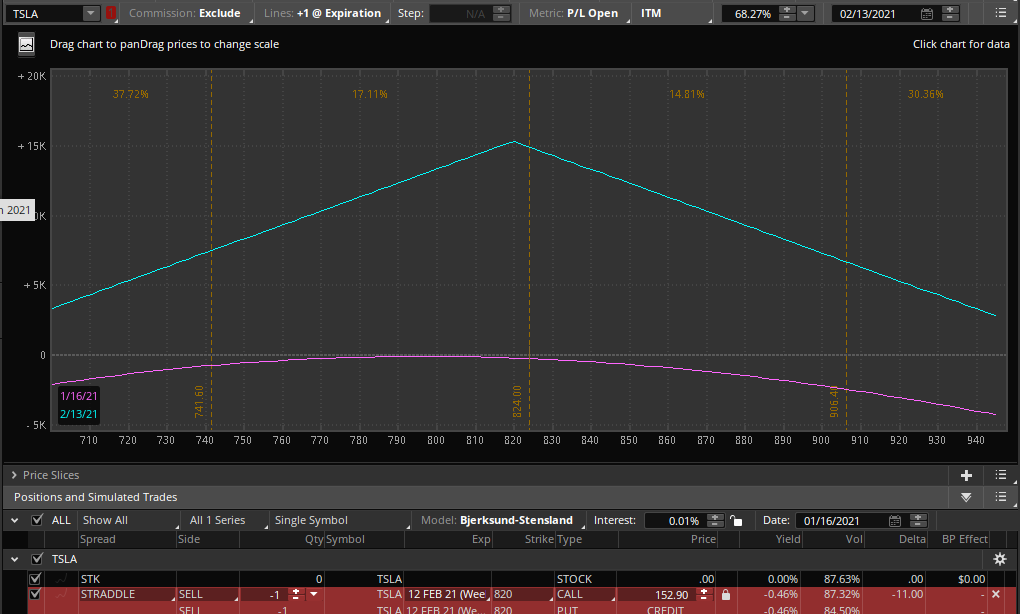This strategy involves selling a call option and a put option with the same expiration and strike price.
A short straddle is a combination of writing uncovered calls (bearish) and writing uncovered puts (bullish), both with the same strike price and expiration. Together, they produce a position that predicts a narrow trading range for the underlying stock.
Before there were options, it was difficult for investors to profit directly from an accurate prediction that didn’t involve a steep rise or fall in the stock. The short straddle is an example of a strategy that does. By collecting two up-front premiums initially, the investor builds a larger margin of error, compared to writing just a call or a put option. However, the risks are substantial on the downside and unlimited on the upside, should a large move occur.
The investor may be able to reduce the chance of assignment by selecting a longer term to expiration, and by monitoring the underlying stock closely and being ready to take quick action. Still no precaution can change the fundamentals: limited rewards for unlimited risk.


EXAMPLE
- Short 1 TSLA 820 call
- Short 1 TSLA 820 put
MAXIMUM GAIN
- Premium received
MAXIMUM LOSS
- Unlimited
Outlook
The strategy hopes for a steady stock price during the life of the options, and an even or declining level of implied volatility.
Because of the substantial risk, should the stock price move out of the expected trading range, the opinion about the stock’s near-term steadiness is likely to be fairly strongly held.
Summary
This strategy involves selling a call option and a put option with the same expiration and strike price. It generally profits if the stock price and volatility remain steady.
Motivation
Earn income from selling premium.
Variations
A short straddle assumes that the call and put options both have the same strike price. See the discussion under short strangle for a variation on the same strategy, but with a higher call strike and a lower put strike.
In yet another application, a cautious but still bullish stockowner could reduce an existing long stock position and simultaneously write an at-the-money short straddle, a strategy known as a protective straddle or covered straddle. For a longer discussion of this concept, refer to covered strangle.
Max Loss
The maximum risk is unlimited. The worst that can happen is for the stock to rise to infinity, and the next-to-worst outcome is for the stock to fall to zero. In the first case, the loss is infinitely large; and in the second, the loss is the strike price. In either event, the loss is reduced by the amount of premium income received for selling the options.
If the stock price is higher than the call strike, the investor will be assigned and therefore obligated to sell stock at the strike price and buy it in the market. If the stock price is lower than the put strike, the investor will be assigned and therefore be obligated to buy stock at the strike price, regardless of the lower market value. That means either liquidating it in the market for an immediate loss, or keeping a stock that cost more than its current market value.
Max Gain
The maximum gain is limited to the premiums received at the outset. The best that can happen is for the stock price, at expiration, to be exactly at the strike price. In that case, both short options expire worthless, and the investor pockets the premium received for selling the options.
Profit/Loss
The potential profit is extremely limited. In the best-case scenario, the short positions are held into expiration and the stock closes exactly at the strike price, and both options expire without being assigned. The investor then keeps the premiums for both the calls and puts.
Any other outcome involves being assigned, or being driven to cover, one or both parts of the straddle. Depending on the stock price, the net result will be either a lesser profit or a loss. The ‘double’ premiums received at the outset offer some margin for error should the stock move in either direction, but the potential for huge losses remains.
Breakeven
This strategy breaks even if, at expiration, the stock price is either above or below the strike price by the total amount of premium income received. At either of those levels, one option’s intrinsic value will equal the premium received for selling both options, while the other option will be expiring worthless.
Upside breakeven = strike + premiums received
Downside breakeven = strike – premiums received
Credit to https://www.optionseducation.org and theocc.com for the educational description.
